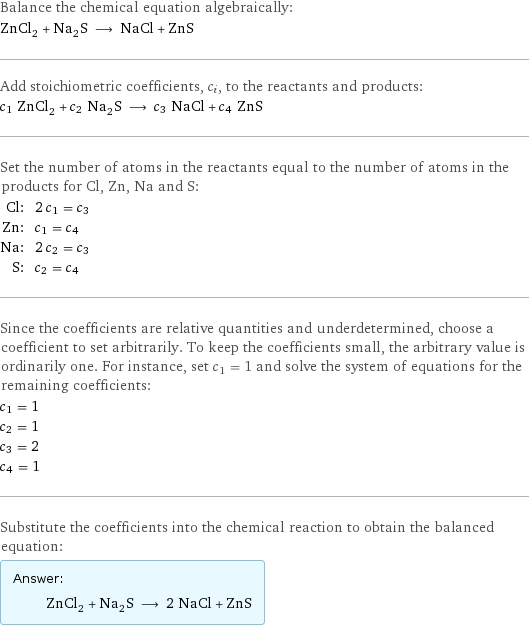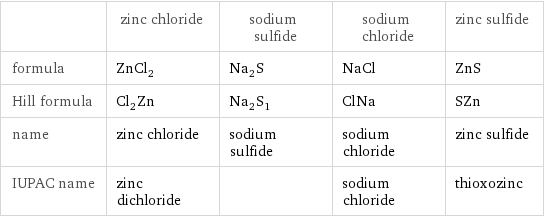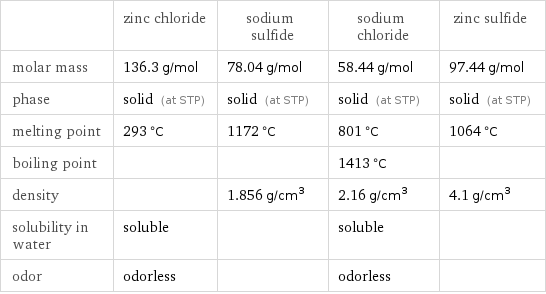Input interpretation

ZnCl_2 zinc chloride + Na_2S sodium sulfide ⟶ NaCl sodium chloride + ZnS zinc sulfide
Balanced equation

Balance the chemical equation algebraically: ZnCl_2 + Na_2S ⟶ NaCl + ZnS Add stoichiometric coefficients, c_i, to the reactants and products: c_1 ZnCl_2 + c_2 Na_2S ⟶ c_3 NaCl + c_4 ZnS Set the number of atoms in the reactants equal to the number of atoms in the products for Cl, Zn, Na and S: Cl: | 2 c_1 = c_3 Zn: | c_1 = c_4 Na: | 2 c_2 = c_3 S: | c_2 = c_4 Since the coefficients are relative quantities and underdetermined, choose a coefficient to set arbitrarily. To keep the coefficients small, the arbitrary value is ordinarily one. For instance, set c_1 = 1 and solve the system of equations for the remaining coefficients: c_1 = 1 c_2 = 1 c_3 = 2 c_4 = 1 Substitute the coefficients into the chemical reaction to obtain the balanced equation: Answer: | | ZnCl_2 + Na_2S ⟶ 2 NaCl + ZnS
Structures

+ ⟶ +
Names

zinc chloride + sodium sulfide ⟶ sodium chloride + zinc sulfide
Reaction thermodynamics
Enthalpy

| zinc chloride | sodium sulfide | sodium chloride | zinc sulfide molecular enthalpy | -415.1 kJ/mol | -364.8 kJ/mol | -411.2 kJ/mol | -206 kJ/mol total enthalpy | -415.1 kJ/mol | -364.8 kJ/mol | -822.4 kJ/mol | -206 kJ/mol | H_initial = -779.9 kJ/mol | | H_final = -1028 kJ/mol | ΔH_rxn^0 | -1028 kJ/mol - -779.9 kJ/mol = -248.5 kJ/mol (exothermic) | | |
Gibbs free energy

| zinc chloride | sodium sulfide | sodium chloride | zinc sulfide molecular free energy | -369.4 kJ/mol | -349.8 kJ/mol | -384.1 kJ/mol | -201 kJ/mol total free energy | -369.4 kJ/mol | -349.8 kJ/mol | -768.2 kJ/mol | -201 kJ/mol | G_initial = -719.2 kJ/mol | | G_final = -969.2 kJ/mol | ΔG_rxn^0 | -969.2 kJ/mol - -719.2 kJ/mol = -250 kJ/mol (exergonic) | | |
Equilibrium constant
![Construct the equilibrium constant, K, expression for: ZnCl_2 + Na_2S ⟶ NaCl + ZnS Plan: • Balance the chemical equation. • Determine the stoichiometric numbers. • Assemble the activity expression for each chemical species. • Use the activity expressions to build the equilibrium constant expression. Write the balanced chemical equation: ZnCl_2 + Na_2S ⟶ 2 NaCl + ZnS Assign stoichiometric numbers, ν_i, using the stoichiometric coefficients, c_i, from the balanced chemical equation in the following manner: ν_i = -c_i for reactants and ν_i = c_i for products: chemical species | c_i | ν_i ZnCl_2 | 1 | -1 Na_2S | 1 | -1 NaCl | 2 | 2 ZnS | 1 | 1 Assemble the activity expressions accounting for the state of matter and ν_i: chemical species | c_i | ν_i | activity expression ZnCl_2 | 1 | -1 | ([ZnCl2])^(-1) Na_2S | 1 | -1 | ([Na2S])^(-1) NaCl | 2 | 2 | ([NaCl])^2 ZnS | 1 | 1 | [ZnS] The equilibrium constant symbol in the concentration basis is: K_c Mulitply the activity expressions to arrive at the K_c expression: Answer: | | K_c = ([ZnCl2])^(-1) ([Na2S])^(-1) ([NaCl])^2 [ZnS] = (([NaCl])^2 [ZnS])/([ZnCl2] [Na2S])](../image_source/771d702d3764eb262754fa5f6eae1a79.png)
Construct the equilibrium constant, K, expression for: ZnCl_2 + Na_2S ⟶ NaCl + ZnS Plan: • Balance the chemical equation. • Determine the stoichiometric numbers. • Assemble the activity expression for each chemical species. • Use the activity expressions to build the equilibrium constant expression. Write the balanced chemical equation: ZnCl_2 + Na_2S ⟶ 2 NaCl + ZnS Assign stoichiometric numbers, ν_i, using the stoichiometric coefficients, c_i, from the balanced chemical equation in the following manner: ν_i = -c_i for reactants and ν_i = c_i for products: chemical species | c_i | ν_i ZnCl_2 | 1 | -1 Na_2S | 1 | -1 NaCl | 2 | 2 ZnS | 1 | 1 Assemble the activity expressions accounting for the state of matter and ν_i: chemical species | c_i | ν_i | activity expression ZnCl_2 | 1 | -1 | ([ZnCl2])^(-1) Na_2S | 1 | -1 | ([Na2S])^(-1) NaCl | 2 | 2 | ([NaCl])^2 ZnS | 1 | 1 | [ZnS] The equilibrium constant symbol in the concentration basis is: K_c Mulitply the activity expressions to arrive at the K_c expression: Answer: | | K_c = ([ZnCl2])^(-1) ([Na2S])^(-1) ([NaCl])^2 [ZnS] = (([NaCl])^2 [ZnS])/([ZnCl2] [Na2S])
Rate of reaction
![Construct the rate of reaction expression for: ZnCl_2 + Na_2S ⟶ NaCl + ZnS Plan: • Balance the chemical equation. • Determine the stoichiometric numbers. • Assemble the rate term for each chemical species. • Write the rate of reaction expression. Write the balanced chemical equation: ZnCl_2 + Na_2S ⟶ 2 NaCl + ZnS Assign stoichiometric numbers, ν_i, using the stoichiometric coefficients, c_i, from the balanced chemical equation in the following manner: ν_i = -c_i for reactants and ν_i = c_i for products: chemical species | c_i | ν_i ZnCl_2 | 1 | -1 Na_2S | 1 | -1 NaCl | 2 | 2 ZnS | 1 | 1 The rate term for each chemical species, B_i, is 1/ν_i(Δ[B_i])/(Δt) where [B_i] is the amount concentration and t is time: chemical species | c_i | ν_i | rate term ZnCl_2 | 1 | -1 | -(Δ[ZnCl2])/(Δt) Na_2S | 1 | -1 | -(Δ[Na2S])/(Δt) NaCl | 2 | 2 | 1/2 (Δ[NaCl])/(Δt) ZnS | 1 | 1 | (Δ[ZnS])/(Δt) (for infinitesimal rate of change, replace Δ with d) Set the rate terms equal to each other to arrive at the rate expression: Answer: | | rate = -(Δ[ZnCl2])/(Δt) = -(Δ[Na2S])/(Δt) = 1/2 (Δ[NaCl])/(Δt) = (Δ[ZnS])/(Δt) (assuming constant volume and no accumulation of intermediates or side products)](../image_source/9b72755211736f665a1abfbfdbe7f62e.png)
Construct the rate of reaction expression for: ZnCl_2 + Na_2S ⟶ NaCl + ZnS Plan: • Balance the chemical equation. • Determine the stoichiometric numbers. • Assemble the rate term for each chemical species. • Write the rate of reaction expression. Write the balanced chemical equation: ZnCl_2 + Na_2S ⟶ 2 NaCl + ZnS Assign stoichiometric numbers, ν_i, using the stoichiometric coefficients, c_i, from the balanced chemical equation in the following manner: ν_i = -c_i for reactants and ν_i = c_i for products: chemical species | c_i | ν_i ZnCl_2 | 1 | -1 Na_2S | 1 | -1 NaCl | 2 | 2 ZnS | 1 | 1 The rate term for each chemical species, B_i, is 1/ν_i(Δ[B_i])/(Δt) where [B_i] is the amount concentration and t is time: chemical species | c_i | ν_i | rate term ZnCl_2 | 1 | -1 | -(Δ[ZnCl2])/(Δt) Na_2S | 1 | -1 | -(Δ[Na2S])/(Δt) NaCl | 2 | 2 | 1/2 (Δ[NaCl])/(Δt) ZnS | 1 | 1 | (Δ[ZnS])/(Δt) (for infinitesimal rate of change, replace Δ with d) Set the rate terms equal to each other to arrive at the rate expression: Answer: | | rate = -(Δ[ZnCl2])/(Δt) = -(Δ[Na2S])/(Δt) = 1/2 (Δ[NaCl])/(Δt) = (Δ[ZnS])/(Δt) (assuming constant volume and no accumulation of intermediates or side products)
Chemical names and formulas

| zinc chloride | sodium sulfide | sodium chloride | zinc sulfide formula | ZnCl_2 | Na_2S | NaCl | ZnS Hill formula | Cl_2Zn | Na_2S_1 | ClNa | SZn name | zinc chloride | sodium sulfide | sodium chloride | zinc sulfide IUPAC name | zinc dichloride | | sodium chloride | thioxozinc
Substance properties

| zinc chloride | sodium sulfide | sodium chloride | zinc sulfide molar mass | 136.3 g/mol | 78.04 g/mol | 58.44 g/mol | 97.44 g/mol phase | solid (at STP) | solid (at STP) | solid (at STP) | solid (at STP) melting point | 293 °C | 1172 °C | 801 °C | 1064 °C boiling point | | | 1413 °C | density | | 1.856 g/cm^3 | 2.16 g/cm^3 | 4.1 g/cm^3 solubility in water | soluble | | soluble | odor | odorless | | odorless |
Units
